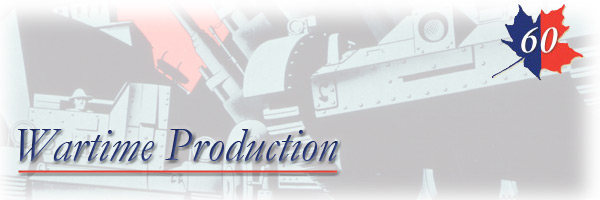
Table of Contents
Home | Joining Up | Military Training in OntarioWartime Production | Fund raising and Volunteerism | Sources and Additional Information
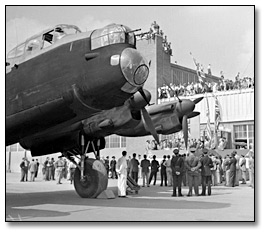
Click to see a larger image (86K)
Ceremonies for Avro-Lancaster bomber,
National Steel Car, 1942
Gordon W. Powley fonds
Black and white negative
Reference Code: C 5-1-0-91-7
Archives of Ontario, I0011328
The effects of the Great Depression had left many factories out of date and unsuited to modern technology.
Despite this, as the war progressed, Canada became a major producer of material for the Allied war effort and many industrial centres in Ontario made important contributions.
Industry in Ontario not only met the demands of the Canadian armed forces but also produced items used by Great Britain, other Commonwealth countries and the United States.
![Photo: Airplane assembly line inside the plant, Canadian Car and Foundry Co., [ca. 1940]](pics/2980_assembly_line_270.jpg)
Click to see a larger image (130K)
Airplane assembly line inside the plant, Canadian
Car and Foundry Co., Fort WIlliam, [ca. 1940]
Canadian Car and Foundry fonds
Black and white print
Reference Code: C 190-5-0-0-21
Archives of Ontario, I0002980
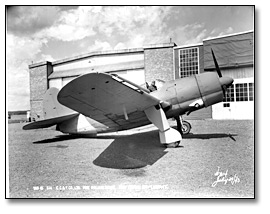
Click to see a larger image (109K)
The first Curtiss SBW-1 aircraft from the Fort William
plant, Canadian Car and Foundry Co., July 29, 1943
Canadian Car and Foundry fonds
Black and white print
Reference Code: C 190-5-0-0-15
Archives of Ontario, I0002978
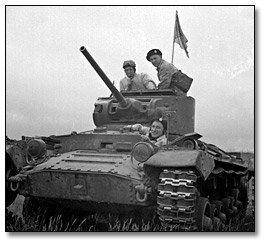
Click to see a larger image (103K)
Tanks engaged in military manoeuvres,1942
Gordon W. Powley
Black and white negative
Reference Code: C 5-1-0-52-8
Archives of Ontario, I0011101
As the war progressed, and the technical requirements changed, Canadian industry expanded into areas of production that had barely existed in the country prior to 1939.
At the beginning of 1939 no armoured vehicles were being produced in this country, but by the end of 1944 14,000 tanks and armoured personnel carriers were being produced annually.
Aircraft production jumped from a handful to more than 4,000 per year by 1944.
In the first year of the war 200 artillery pieces were produced. By 1944 that number had risen to 16,000.
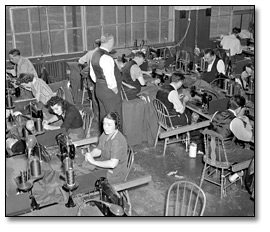
Click to see a larger image (126K)
Making uniforms at Tip Top Tailors
Gordon W. Powley
Black and white negative
Reference Code: C 109-2-0-18
Archives of Ontario, I0016684
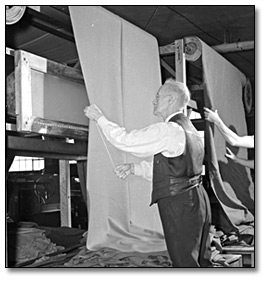
Click to see a larger image (101K)
Making uniforms at Tip Top Tailors
Gordon W. Powley
Black and white negative
Reference Code: C 109-2-0-18
Archives of Ontario, I0016683
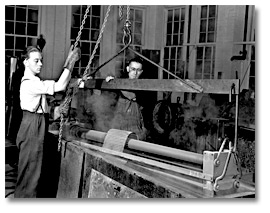
Click to see a larger image (102K)
Bofors Anti-aircraft gun production,
Hamilton, April 11, 1941
Gordon W. Powley
Black and white negative
Reference Code: C 109-2-0-18
Archives of Ontario, I0008802
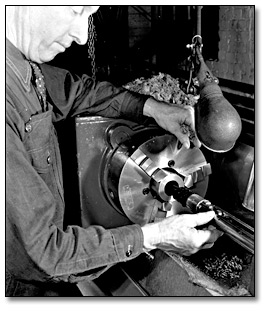
Click to see a larger image (104K)
Bofors Anti-aircraft gun production,
Hamilton, April 11, 1941
Gordon W. Powley
Black and white negative
Reference Code: C 109-2-0-18
Archives of Ontario, I0008800
With many working age men being drawn into the various branches of the military, labour shortages started to be felt in other sectors. Workers, both skilled and unskilled, were required to equip the war machine. This demand continued to increase throughout the war and many of the positions were filled by women.
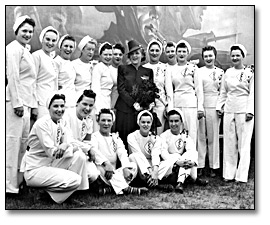
Click to see a larger image (123K)
Mary Pickford posing with a group of employees
during her visit to the General Engineering
Company (Canada) munitions factory, June 5, 1943
General Engineering Company (Canada) fonds
Black and white print
Reference Code: F 2082-1-2-10
Archives of Ontario, I0004930
Women became involved in all aspects of war production. One area that saw a tremendous growth in the percentage of female employees was manufacturing, as companies all across Canada encouraged women to join their ranks.
One such factory was the General Engineering Company, a Scarborough (Toronto) munitions plant that manufactured ammunition of all calibres.
Let's Visit (1945) is a radio program that follows a new worker through her orientation to the factory. The program stresses the desirability of industrial work for women, and tries to counter the traditional view of such work as dirty and dangerous.
Clips from the radio program are included here.

Let’s
Visit (1945) – This clip provides an introduction
to the program.
To listen to this excerpt in "wav" format (1.6Mb) click here. It is also available in "aif" format (1.61Mb).
Let's Visit (1945)
General Engineering Company (Canada) fonds
Radio transcription disk
Reference Code: F 2082-1-3-1

Let’s Visit (1945) – This clip includes the assistant foreman speaking about the plant safety record.
To listen to this excerpt in "wav" format (1.0Mb) click here. It is also available in "aif" form at (1.01Mb).
Let's Visit (1945)
General Engineering Company (Canada) fonds
Radio transcription disk
Reference Code: F 2082-1-3-1

Let’s
Visit (1945) – This clip talks about the
recreation program provided by the company.
To listen to this excerpt in "wav" format (1.9Mb) click here. It is also available in "aif" format (1.91Mb).
Let's Visit (1945)
General Engineering Company (Canada) fonds
Radio transcription disk
Reference Code: F 2082-1-3-1

Let’s
Visit (1945) – This clip talks about the
health and beauty program and a pinup contest.
To listen to this excerpt in "wav" format (715K) click here. It is also available in " aif" format (716K).
Let's Visit (1945)
General Engineering Company (Canada) fonds
Radio transcription disk
Reference Code: F 2082-1-3-1
Another company that encouraged women to join their workforce was the Canadian Car and Foundry Company in Fort William (now Thunder Bay) and Brantford.
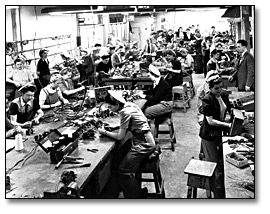
Click to see a larger image (133K)
Women soldering and assembling cables for airplanes,
Canadian Car and Foundry Co., Brantford, 1945
Canadian Car and Foundry fonds
Black and white print
Reference Code: C 190-5-0-0-43
Archives of Ontario, I0002965
![Photo: Women working at the General Engineering Company (Canada) munitions factory, [ca. 1943]](pics/4899_women_and_coll_270.jpg)
Click to see a larger image (87K)
Women working at the General Engineering
Company (Canada) munitions factory, [ca. 1943]
General Engineering Company (Canada) fonds
Black and white print
Reference Code: F 2082-1-2-6
Archives of Ontario, I0004899
At the end of 1939 there were 121,000 individuals involved in war production.
By 1943, when industrial expansion reached its peak, that number had grown to over 1 million.
Even more striking, the number of women amongst this group increased from 6,000 to 261,000 in the same time period.

Even thousands of miles from the front it was impossible to forget a war was going on, and security for war production was always an issue.
In March 1941 Ontario’s Controller of Finances, C. S. Walters, wrote C. D. Howe, National Minister of Munitions, Supply and Transport, of his concerns about security for ships under construction at Toronto’s waterfront.
|
“I notice four or five corvettes being constructed here at the foot of Spadina Avenue and I have observed curious people crowded around. It has occurred to me that these ships should be guarded to prevent their being damaged or destroyed.” |
Howe replied on March 12th:
|
“I thank you for your letter of March 11th, with reference to the construction of corvettes in the Dufferin Shipbuilding plant at Toronto. I am forwarding your letter to the Director General of Shipbuilding with the request that adequate steps be taken for the protection of these vessels” RG 6-15, Interministerial and intergovernmental correspondence of the Treasury Department. File Federal Government No. 25 War Effort and National Defence. |
![Photo: Ship being built in Toronto, [ca. 1945]](pics/2724_crane_270.jpg)
Click to see a larger image (82K)
Ship being built in Toronto, [ca. 1945]
Gordon W. Powley
Black and white negative
Reference Code: C 5-1-0-102-4
Archives of Ontario, I0002724
In addition to protecting the shipyards and factories from sabotage, the provincial government was concerned about the implications of modern warfare and the power of the long range bomber. The German air raids on England in 1940 and 1941 were graphic examples of the potential for mass destruction.The Premier of the day, Mitchell Hepburn, ordered the creation of a Civil Service Civilian Defence Committee which would coordinate civil defence measures in the vicinity of Queen's Park.
![Photo: View of Minesweeper, HMS Qualicum, [ca. 1945]](pics/11148_minesweeper_270.jpg)
Click to see a larger image (68K)
View of Minesweeper, HMS Qualicum, [ca. 1945]
Gordon W. Powley
Black and white negative
Reference Code: C 5-1-0-71-1
Archives of Ontario, I0011148
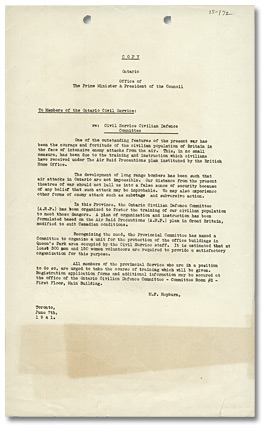
Click to see a larger image (179K)
Interministerial and intergovernmental correspondence of the Treasury Department. File Federal Government No. 25 War Effort and National Defence.
Reference Code: RG 6-15
Archives of Ontario
Joining Up | Military Training in Ontario | Wartime Production
Fund raising and Volunteerism | Sources and Additional Information

